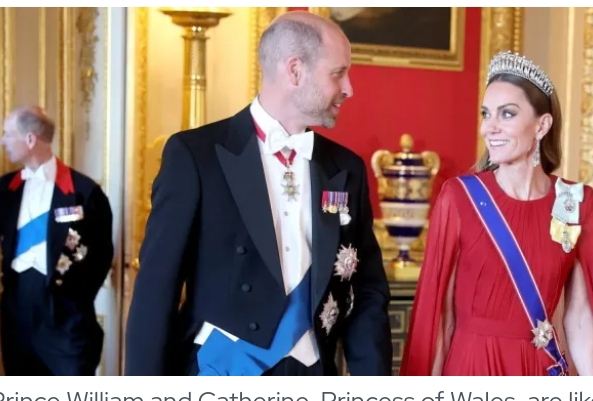CELEBRITY
BREAKING NEWS: William’s plan for being king: Save money and ‘work smarter’ than Charles

The Prince of Wales will slim down the monarchy and Royal Household even further when he is crowned. While it will save taxpayers money, it will also shape the way he carries out his duties.
The Prince and Princess of Wales’s new eight-bedroom home affords spectacular views of Windsor Castle and an intriguing glimpse of our future monarchy under King William V.
From the top floor of Forest Lodge, a Grade II listed, three-storey, red-brick mansion dating back to 1780, William and Kate will be able to surveil the oldest and largest occupied castle in the world, home to 40 monarchs since William the Conqueror began its construction in 1070.
But, in a break with tradition signalling a new style of monarchy, the couple -who expect to move from their current four-bedroom home at nearby Adelaide Cottage to Forest Lodge, in a quiet corner of Windsor Great Park, before Christmas – will never live at the castle three-and-a-half miles away.
Nor will they live at Buckingham Palace or probably any other royal palace when William becomes king.
Their plan to become the first king and queen not to live in a palace or castle in over a thousand years of royal history stems from a desire to create a family home that is as normal as possible, a refuge from the fishbowl in which monarchs have lived, surrounded by servants and courtiers, for centuries.
King William’s slimmed down monarchy
Under King William, the number of working Royals is expected to fall to five or six, around half the number now and a third of the total at times during the reign of Elizabeth II.
“William won’t have cousins helping him like the Queen [Elizabeth] did. So he’ll have to work smarter,” one royal source said.
It is likely to mean more of a focus on short-term campaigns and events bringing various charities together, rather than the king and his family each representing hundreds of voluntary organisations.
Princess Anne, who marked her 75th birthday on 15 August, has indicated she is prepared to work on, and Edward and Sophie, once minor figures, are expected to play an increasingly prominent role in this reign and the next under William.
But there will be no room for their children on the taxpayer-funded payroll.
Prince George, the 12-year-old future king, will undertake his own royal duties eventually, perhaps after a spell in the Armed Forces, but it is too early to say for definite yet whether his siblings Princess Charlotte, 10, and Prince Louis, seven, will have careers outside of the Firm or will be working royals supporting the family.
“William and Catherine are modern parents. They may have their thoughts but I think they’ll wait to see what the children want to do,” one former senior aide said, refusing – like several others – to rule out the possibility that both Charlotte and Louis could ultimately have careers outside the family.
No role for Archie or Lilibet
If Prince Harry and Meghan had stayed, they would have had a prominent role, but the chances of their children, Prince Archie, six, and Princess Lilibet, four, representing the British monarchy in the future are said to be negligible and probably would have been even if their parents had remained.
William V’s reign is likely to continue to embrace the pomp and ceremony for which the Royal Family is famous, but in many ways it will start to resemble more closely their more informal and modest counterparts in Europe, the “bicycling monarchies”.
Once seen as a negative by Britons wedded to the grandeur of our royalty, these more informal monarchies are now just as popular, if not more so, than ours domestically. What worked for Queen Elizabeth often does not for King Charles and when William becomes king, it is likely that we will see an even more informal style.
Even during official engagements there will often be less formality. William, like his brother Prince Harry, has never really wanted to have line-ups of dignitaries at every event and is no fan of Lord Lieutenants, the monarchy’s ceremonial official representatives in each county whose expenses cost taxpayers around £1.5m a year.
In 2016 William suggested he would be less political than his father and more like his grandmother Queen Elizabeth. But since then he and Kate have eschewed many of the traditional ribbon-cutting duties, choosing instead to focus on a small number of campaigns, such as ending homelessness, combating climate change, and giving children a better start in life.
That approach is expected to continue in the next reign. “It’s all about impact,” one senior aide said.
A smaller number of working Royals doing fewer engagements should mean fewer staff – the couple currently employ 68, about half the number who worked for Charles at his peak as Prince of Wales. It could also mean a real-terms drop in the cost of the monarchy, and possibly savings for the taxpayer.
The Palace, which is already sensitive to criticism about the cost of the monarchy, and worried about a review of the Sovereign Grant due in 2027, will be conscious of the need to save money.
How much money, exactly, remains to be seen. At the moment the cost of monarchy amounts to £132m directly from the taxpayer in the Sovereign Grant, rising to an estimated £500m when security and various other funding sources are added.
Some worry that tourism to the UK will suffer without the monarch living at Buckingham Palace, Windsor Castle or some of the other residences. William and Kate, for example, are expected to keep Anmer Hall on the Sandringham estate, and use only Sandringham House for official functions or big gatherings.
But Bernard Donoghue, director of the Association of Leading Visitor Attractions, doubts it. “The most significant occasions – such as investitures, presentations, state visits, wedding receptions and garden parties – would still take place at Buckingham Palace, Windsor Castle, the Palace of Holyroodhouse and Hillsborough Castle, and that’s how most people know them and why they wish to visit them.”
Charles, who is reluctant to move into Buckingham Palace when its £369m refurbishment is completed in 2027, already uses Birkhall instead of Balmoral Castle in Scotland and, although he stays at Windsor Castle, prefers his Highgrove home in Gloucestershire.
When he acceded to the throne in 2022 and when he became ill with cancer last year, aides were reluctant to discuss what sort of king his son would be, arguing that it was in poor taste.
Now, with Charles back to a normal workload but still undergoing cancer treatment, some friends of the family have begun briefing about William’s future plans. It is unclear whether that is to prepare us for a change of reign sooner than expected, or a sign of confidence that there is not going to be one in the foreseeable future. But the mood music from the King’s office is upbeat.












